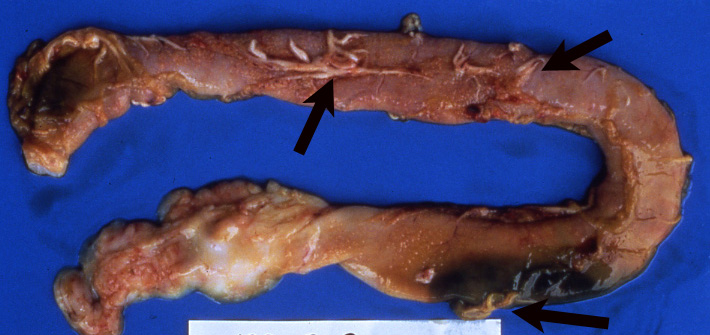
| Parasite | Psettarium sp. |
|---|---|
| Taxonomy | Platyhelminthes, Trematoda, Strigeidida |
| Host | Tiger puffer (Takifugu rubripes) |
| Disease name | Blood fluke disease |
| Infection site | Visceral vascular system |
| Clinical sign | Usually, no external signs are evident, but heavily infected fish sometimes exhibit abnormal swimming. The visceral blood vessels are filled with a number of blood flukes, resulting in dilation of the vessel (Fig. 1). Numerous eggs of the parasite are found in the capillaries of various viscera. |
| Parasitology | Psettarium sp. TPJ (6-10 mm in length) (Fig. 2), parasitizing tiger puffer of Japan, is differentiated from Psettarium sp. TPC (3-5 mm), parasitizing tiger puffer of China, by the presence of 2-6 rows of pre-oral spines in the latter species (Ogawa et al., 2007). Both parasites are found in the visceral blood vessel and sometimes in the afferent branchial artery and the renal artery. Diseased fish are often observed from July to August, but the life cycle is unknown. The intermediate host is probably involved in the life cycle. |
| Pathology | Infected fish exhibits circulatory impairment due to occlusion of the visceral blood vessel with parasite eggs. The eggs are accumulated in various organs including spleen, liver, kidney and gut, leading to formation of the granuloma around the eggs. |
| Health hazard | Since this parasite is not infectious to human, it is harmless in food hygiene. |
| Diagnosis | Confirm the parasite or parasite eggs in the visceral vascular system. Check the morphology of the pre-oral region for the definitive diagnosis. |
| Other information | Until recently, this disease has not become a problem in cultured tiger puffer in Japan since a blood fluke was only once found in tiger puffer kept in captivity of Wakasa Bay in 1993. However, a similar blood fluke was observed in tiger puffer seedlings introduced from China in 2005. Subsequently, the morphological examination proved that the latter parasite (Psettarium sp. TPC) is not the same species as the one found in 1993 (Psettarium sp. TPJ) (Ogawa et al., 2007). No evidence is found that the life cycle of Psettarium sp. TPC is completed in Japanese waters. |
| References | Ogawa, K., T. Nagano,
N. Akai, A. Sugita and K. A. Hall (2007): Blood fluke infection of cultured
tiger puffer Takifugu rubripes imported from China to Japan. Fish Pathol., 42, 91-99.
|

(Photos by A. Sugita (1) and K. Ogawa (2))
Fig. 1. Dilation of the visceral blood vessels (arrows) of tiger puffer
caused by the blood fluke.

Fig. 2. Psettarium sp. TPJ from tiger puffer.